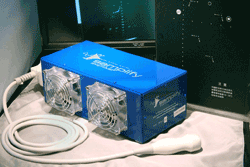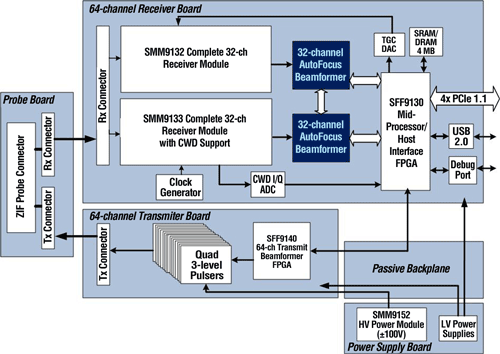Developing and evaluating complex ICs in medical apps
Electronic subsystems require a system-level approach
BY DANIEL KREINDLER
Director Medical Products
Samplify Systems
www.samplify.com
In the not too distant past, most ICs could be designed and manufactured to a written specification. When the IC would come back from manufacturing it would be tested on a rather limited evaluation board or EVB that allowed the designers to input real data into the chip and collect the output data to verify the IC’s performance against the specifications. However, in today’s increasingly complex electronic systems, signals and data go through a long signal processing chain from the point where they are acquired to the point where they are consumed as meaningful information. Many components in the signal chain perform one or several functions which constitute a part of the overall processing. The interaction between the various parts of the signal chain, and their affect on the results at the end of the chain, is becoming increasingly complex. As a result, designing a highly advanced IC to a spec is now quite difficult. To solve this problem, a fully functional emulation system is needed to tune and optimize these types of designs because the true metric of performance for any device in the chain can only be evaluated by building the entire chain.
In this article, a highly complex IC, implementing an ultrasound receive beamformer function, will be used to demonstrate the need for a system-level approach to its design and evaluation. A clear example of the previously mentioned long signal chain can be seen in ultrasound imaging equipment. The first digital-signal-processing function in the ultrasound receiver signal chain is the beamformer. This function is very critical and ultrasound front-ends are often specifically designed around the beamformer. In front of the beamformer there is an analog stage and analog-digital converter. Many digital functions follow the beamformer including demodulation, filtering, log compression, scan conversion, Doppler processing and more. Furthermore, there are other critical electronic components that affect the system including a complete transmit signal chain and of course the power supplies and power distribution systems. On top of all this hardware there is complex software, both for control, sequencing, and timing, as well as further signal processing on the data acquired from the front-end electronics.
Developing an ultrasound receive beamformer IC
Many ICs are complex as a whole, but their internal blocks operate mostly independent of each other and their interaction with components in front and behind them in the signal chain are somewhat limited and mostly well defined. In this type of IC, blocks and most of the entire IC can be designed, simulated, emulated, tested, and evaluated as a separate entity. This is not the case for the highly configurable high-performance ultrasound receive beamformer IC that is currently being developed.
To develop this type of merchant ultrasound receive beamformer IC, a semiconductor company must take a system-level approach. To properly design and test a new receive beamformer IC today requires the manufacturer to use a development platform (Fig. 1 ). For example, when Samplify began developing its beamformer IC, it did not have any existing systems to “plug” its new device into for testing and optimizing. The company had to build a development platform to provide that system.

Fig. 1: The SMK9130 ultrasound beamforming front-end development platform.
Employing this platform enabled the engineers to use standard test, debug, and bring-up techniques such as observing signals and noise on an oscilloscope screen. But unlike a simple EVB, the development platform offers a system-level view of the performance of the chip. The development platform allows the component design engineers to view complex images of internal organs and blood flow velocity and direction similarly to how a clinician or doctor end-user of an ultrasound system would, not on an oscilloscope screen, but on an ultrasound display.
The development platform created for this system-level approach is also quite complex. As can be seen in the block diagram in Fig. 2 , there are a lot of components surrounding the receive beamformer ICs (in dark blue). Using large FPGA (field programmable gate array) devices allows for emulating the IC itself and tuning and optimizing the algorithms. Since the device under design is a receive beamformer, the entire receive signal chain from the transducer interface to the host interface to a back-end CPU is required. But, in this case, the complexity of the system-level approach does not end there. To properly input real ultrasound data, a complete transmit signal path was developed as well. Furthermore, the receive and transmit control paths interact very tightly as sequencing of transmit firings and beam reception is critical to the performance at the system-level. Having a system such as Samplify’s SMK9130 development kit allows for iterative tuning and optimizing of the IC design with the end-product (in this case, an ultrasound image) in the feedback loop.

Fig. 2: Samplify’s SMK9130 AutoFocus beamforming front-end development platform block diagram.
Beyond assuring the design of an optimized product, investment in developing such a system keeps paying off. It is used for testing the IC and demonstrating its performance just like any EVB that is developed for a new chip. Going one step further, developing a high-level API (application programming interface) to allow user software to interface to the development platform will obfuscate all the details of the hardware in the system while exposing all the functionality of the beamformer to the user.
Front-end electronics are the major subsystem of a complete ultrasound machine alongside other subsystems that include probes, the back-end computer running the ultrasound software, user interface, display etc. Thus, implementing a system-level approach using a development platform to create component-level products, such as a receive beamformer IC, allows designers who use these components to use the very same platform when developing their next-generation ultrasound systems. ■
Advertisement
Learn more about Samplify Systems





